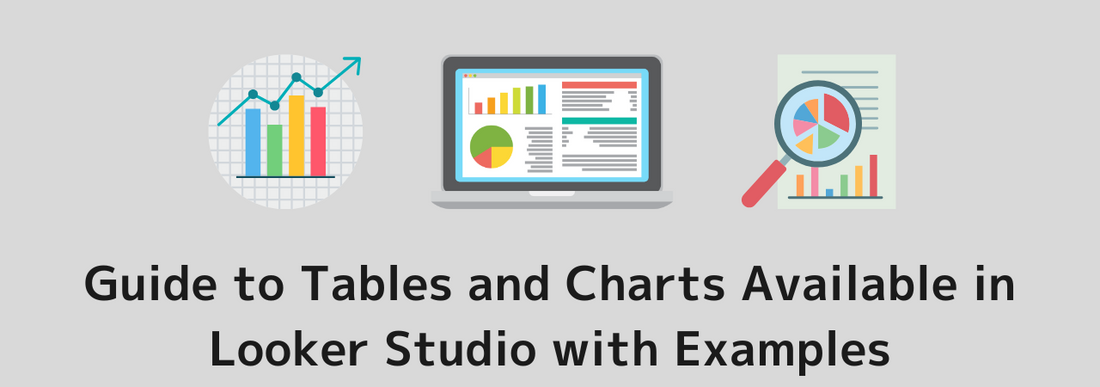In this article, we will showcase various charts and tables that can be visualized in Looker Studio reports. Looker Studio offers a wide range of charts tailored to different purposes. Use the list of charts and tables introduced here as a reference for creating your reports. The charts will primarily be created using GA4 data.
Scorecard
You can display the numerical value of a single metric using a scorecard. This feature is often used to showcase key KGI or KPI metrics. Here, we will introduce several examples of scorecard representations. In GA4, metrics such as sessions, user count, key event counts, and revenue are commonly displayed in scorecards. Beyond simply showing numbers, you can enhance scorecards by adding sparklines to visualize trends or by including percentages and progress indicators to track performance against specific goals.

Compact numbers scorecard
You can also display a shortened scorecard with numbers for better visual clarity, especially when dealing with large numbers.

(Quote:Looker Studio)
Table
You can display a table composed of rows and columns. Metrics are shown for each dimension, aggregated based on the selected dimensions. Multiple metrics can be set. The table can display only the values of the selected metrics or show them alongside the increase or decrease compared to a specific period.

(Quote:Looker Studio)
Table with bars
Here is a table that visually represents the magnitude of values using bars, making it easy to understand at a glance. You can display just the bars or show both the bars and numerical values side by side.

(Quote:Looker Studio)
Table with heatmap
This table represents numerical values using a heat map instead of bars. By adjusting the settings, you can also combine a table with bars and a heat map for simultaneous use.

(Quote:Looker Studio)
Pivot table
You can create pivot tables by specifying dimensions for rows and columns. This is useful when you want to view metrics based on combinations of dimensions. For example, it’s convenient for creating a monthly table of a specific dimension, as shown in the example.

(Quote:Looker Studio)
Pivot table with bars
You can also display it with bars, just like a table.

(Quote:Looker Studio)
Pivot table with heatmap
Heat maps can also be represented using pivot tables.

(Quote:Looker Studio)
Time series chart
You can display the trend of metric data over a specific period. This type of graph makes it easy to understand how numbers change over time, such as on a daily or monthly basis. Since you can set breakdown dimensions, it's possible to visualize daily trends by default channel group or show trend lines for specific metrics.

(Quote:Looker Studio)
Sparkline chart
You can display a line chart without axes. This is useful for getting a general sense of the trends in your metrics.

Smoothed time series chart
A smoothed time series chart connects data points with smooth curves instead of straight lines. When choosing the format for your chart, consider which option—straight lines or curves—makes trends easier to understand based on the metric, and which design better suits the overall style of your report.

(Quote:Looker Studio)
Bar chart
You can use bars to represent numerical changes or differences across categories. The graphs can be displayed not only as vertical bar charts but also as horizontal bar charts. Vertical bars are often used to show trends over time, while horizontal bars are typically used to compare metrics across specific categories.

(Quote:Looker Studio)
Stacked bar chart
You can create a stacked bar chart by setting a breakdown dimension in the bar chart, allowing you to visualize the breakdown of the total.

(Quote:Looker Studio)
100% Stacked bar chart
A 100% stacked bar chart is effective for understanding the proportions of breakdowns, as all the bars are displayed at the same length.

(Quote:Looker Studio)
Pie chart
The pie chart is well-suited for representing the proportions of a certain metric across different categories. You can also customize the number of slices displayed on the chart, choosing any value between 1 and 20.

(Quote:Looker Studio)
Donut chart
A donut chart is a type of pie chart with a hollow center. The empty center space allows you to add additional information, such as text. You can also adjust the size of the central space with fine-tuned settings.

(Quote:Looker Studio)
Combo chart
You can combine line charts and bar charts to display multiple metrics in a single graph. This is ideal for observing trends in related metrics, such as active users and sessions.

(Quote:Looker Studio)
Stacked combo chart
You can also display bar charts in a combo chart as stacked bars. However, note that the stacking option is only available for bar charts and cannot be applied to line charts.

(Quote:Looker Studio)
Line chart
You can also set all metrics in a combo chart to line graphs. The difference from the previously introduced time series chart is that you can specify dimensions other than time-based ones, such as date or week.

(Quote:Looker Studio)
Smoothed line chart
Like the period graph, you can also create a line graph with smooth curves connecting the points instead of straight lines.

Area chart
An area chart is a graph where the area beneath a line chart is filled with color, making it easier to visualize changes in numerical values over time. You can adjust the number of displayed colors from 1 to 20, allowing for configurations such as displaying only the top 5. In the example, the chart shows the daily trend of sessions broken down by source/medium.

(Quote:Looker Studio)
Stacked area chart
This is a stacked area chart that displays the breakdown dimension in a layered format. It helps visualize the proportion of the breakdown dimension while also understanding the total values of the metrics. You can adjust the number of displayed colors from 1 to 20, making it possible to display, for example, only the top 5 items.

(Quote:Looker Studio)
100% Stacked area chart
The line chart displays metrics on the vertical axis at 100%, making it easy to view metrics as percentages. You can also adjust the number of colors displayed, from 1 to 20, allowing you to show only the top 5 items, for example.

(Quote:Looker Studio)
Map
If a dimension includes regional data, you can display a map and visualize metrics on it. Here are some examples of graphs that can be presented in a map format.
Bubble map
You can create a map visualization where the size and color of the bubbles represent the values of specific metrics. To use this feature, a geographic dimension is required. The map allows for dynamic zooming in and out after setting a default position.

(Quote:Looker Studio)
Filled map
You can create a map chart that visualizes regions by shading areas based on the magnitude of a selected metric. To use this feature, a geographic dimension is required. The map dynamically allows zooming in and out while maintaining a default position.

(Quote:Looker Studio)
Heatmap
You can create a heat map graph that visualizes areas on a map based on the magnitude of a metric's values. To use this feature, a geographic dimension is required. The map allows for dynamic zooming in and out, starting from a default position.

Combo map
You can represent map areas using both shaded regions and bubbles. The bubbles can also be displayed in 3D. To utilize these features, a geographical dimension is required. The map allows dynamic zooming in and out, starting from a default position.

(Quote:Looker Studio)
Geo chart
You can display a map that defines specific areas and color-codes them based on the volume of metrics. In this format, zooming in and out on the map is not possible.

(Quote:Looker Studio)
Scatter chart
You can clearly illustrate the relationship between multiple metrics for a specific dimension. The number of bubbles displayed on the graph can be adjusted as needed. In the example, each point represents a page, with the vertical axis showing the number of sessions and the horizontal axis representing the engagement rate. Additionally, only the top 20 pages with the highest number of sessions are displayed. This allows you to identify pages that have a high number of sessions but a relatively low engagement rate.

(Quote:Looker Studio)
Bubble chart
In scatter plots, the size of all circles is the same, but in bubble charts, the size of each circle can be adjusted based on specific metrics. In the example, circles are sized proportionally to the number of impressions, with higher impressions resulting in larger circles.

(Quote:Looker Studio)
Bullet chart
This type of chart is useful for understanding how close a specific metric is to its target value. In the example, the vertical line at 500 represents the target value, while the length of the blue horizontal bar indicates the current value. The background can also be divided into three color-coded areas, and you can set the target and area widths using numerical values. This is ideal for visualizing key event counts or revenue targets in GA4.

(Quote:Looker Studio)
Gauge
This graph, similar to a bullet graph, helps visualize the progress of a specific metric. In the example, the maximum value for key events is set at 800, while the target in the graph on the right is 700, illustrating the current progress. In GA4, this type of visualization is particularly suitable for displaying goals such as the number of key events or revenue targets.

Gauge with ranges
The gauge chart now includes ranges, making it easier to understand progress within each range. In the example, the ranges are divided into 0 to 250, 250 to 500, and 500 to 7000, with the graph displaying color-coded sections for each range.

(Quote:Looker Studio)
Treemap
A treemap is a type of chart that helps visualize the proportion of each dimension using the size and color of rectangles based on metric values. In the example, the number of events occurring on the site is displayed as a treemap categorized by event names. Additionally, you can use treemaps to represent sales by product categories or individual products.

(Quote:Looker Studio)
Boxplotchart
To create a box-and-whisker chart, you need the minimum value, 25th percentile, median, 75th percentile, and maximum value of a metric. However, since GA4 connector data sources in Looker Studio already aggregate metrics, the metrics available for use are limited. That said, you can create a box-and-whisker chart using custom datasets. In the example provided, the chart displays the minimum value, 25th percentile, median, 75th percentile, and maximum value of daily sales.
For more details on aggregated metrics and percentiles, refer to How to Use and Apply the PERCENTILE Function in Looker Studio | Calculated Fields.

(Quote:Looker Studio)
Candlestick chart
To create a candlestick chart, you need the opening price, closing price, high price, and low price for each range. This means that the metrics available for use are limited when using a GA4 connector data source, as the metrics are already aggregated. However, candlestick charts can be created with custom data. They are particularly common for visualizing stock price data.

(Quote:Looker Studio)
Sankey
A Sankey chart is a type of graph that visualizes flows and shows how metric values transition. In the example, GA4 data is used to illustrate the relationship between traffic sources and landing pages. The left side represents the traffic sources, while the landing pages are displayed on the right. The thickness of the lines corresponds to the number of users.

(Quote:Looker Studio)
Waterfall
A waterfall chart is a type of graph that illustrates increases and decreases in metrics. It is commonly used for financial data and requires incremental values as the metric. In the example, it displays the monthly changes in revenue and the final total value.

(Quote:Looker Studio)


![GA4 Summary Report Template[4013]](http://88studio.io/cdn/shop/files/4013thumbnail.png?v=1733209235&width=533)
![GA4 Monthly Report Template[4007]](http://88studio.io/cdn/shop/files/4007_GA4-monthly-report-firstview_80551e9b-22ec-47d9-a375-29691372a34f.jpg?v=1702969299&width=533)
![GA4 EC Monthly Report Template[4008]](http://88studio.io/cdn/shop/files/4008_75c0c108-4e41-4fee-87ec-e7c823b6939d.png?v=1743466274&width=533)
![GA4 Standard Report Template[4004]](http://88studio.io/cdn/shop/files/4004_f67fd549-68fe-46c3-b8bc-57b0cad056ee.png?v=1740969729&width=533)
![GA4 EC Standard Report Template[4012]](http://88studio.io/cdn/shop/files/4012v2.0.png?v=1745371761&width=533)
![Google Ads Report Template[4003]](http://88studio.io/cdn/shop/files/4003_v2_1.png?v=1737458695&width=533)
![SEO Standard Report Template [4002]](http://88studio.io/cdn/shop/files/4002v2.0.png?v=1747814286&width=533)
![GA4 EC Basic Dashboard Template[4010]](http://88studio.io/cdn/shop/files/4010v2.0.png?v=1745966967&width=533)
![SEO Monthly Report Template[4011]](http://88studio.io/cdn/shop/files/4011_v2.png?v=1737028939&width=533)
![GA4 Dashboard Template[4009]](http://88studio.io/cdn/shop/files/4009v2.0.png?v=1740388404&width=533)